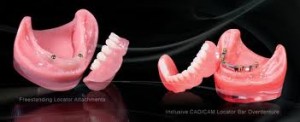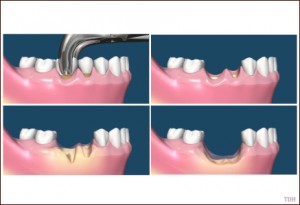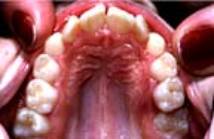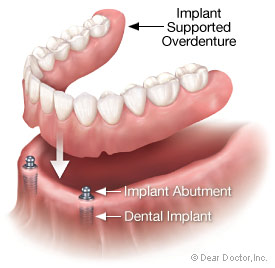Advanced periodontal or gum disease usually cause loose or painful teeth. If many of your teeth have become loose or painful, it may be too late for to save them. In such a situation, removing some of your teeth and replacing them with an overdenture may be the best way to avoid infection and restore function and health to your mouth.
What is an overdenture?
An overdenture is defined as a removable partial denture or a complete denture that covers and rests on one or more remaining natural teeth, the roots of natural teeth, and/or dental implants.
It is also known as overlay denture, hybrid prosthesis, telescoping denture or tooth supported denture.
Rationale of overdentures
Retention of any tooth for an overdenture preserves a portion of one of the major sensory inputs, for example input from the periodontal proprioceptors that respond to position and movement enabling better enjoyment of food.
Studies show that the use of an overdenture preserves the alveolar or jaw bone, especially in the area of retained teeth. With a regular denture, when all our teeth are removed, it causes bone in the jaw to recede. However, when an overdenture is placed, some of the natural teeth retained are used to anchor the denture. By leaving some of the roots of the teeth in place, bone loss can be significantly fended off bone loss and a more stable denture can be provided.
Advantages of overdentures
- Equally effective and superior method of treatment, especially in patients with inborn defects (for example cleft palate and microdontia)
- Simplicity of construction
- Ease of maintenance
- Stability due to retained roots or implants
- Retention
- Open palate possible
- Excellent patient acceptance
- Possibility of using attachments or soft liners
- Transitional or training denture in preparation for receiving a complete denture
- Ease of cleaning
- Proprioceptive ( the ability to detects motion or position) response
- Distribution of forces of mastication
Disadvantages of overdentures
- The overdenture treatment is more expensive and time consuming than conventional denture treatment
- The overdenture is bulkier than the fixed or removable partial denture
- Many individuals do not like any removable appliance and therefore may prefer a fixed partial denture
- If the individual does not keep the retained roots or teeth and the overdenture clean, cavities and gum disease may progress
- Maintenance problems – copings may become loose,  overdenture attachment wear, loss and breakage, overdenture breakage, oral hygiene problems
Indications of overdentures
- Younger the individual, the greater the indication
- In situations where retention is difficult to obtain, for example dry mouth, absence of alveolar residual ridge, loss of upper jaw or partial loss of lower jaw, congenital deformity (such as cleft palate)
- For individuals with poor prognosis for complete dentures, for example high palatal vault and ridge shape, poorly defined sublingual space, and knife edge ridge
- When complete denture will be opposed by retained lower front teeth thus preventing combination syndrome
Contraindications of overdentures
- Uncooperative, under motivated individuals
- Psychologically some individuals cannot accept removable prosthesis
- Mentally and physically compromised
Types of overdentures
Transitional overdentures
A transitional or interim overdenture is made from an existing removable partial denture, the individual’s own teeth or from both, that is to be replaced after a suitable transitional period.
Immediate overdentures
An immediate overdenture is an overdenture constructed for insertion immediately after the removal of natural teeth; it may be used as an interim prosthesis.
Remote or definitive overdentures
A remote overdenture is an overdenture other than transitional or immediate overdentures. It is usually constructed for insertion at sometimes remote from the removal of hopeless natural teeth. Although remote overdentures can be entirely constructed of resin, metal bases are frequently used.
Implant overdentures
A wide variety of implant types and procedures have been used with an overdenture as the means of a final restoration. Although it is used mostly with fixed types of prosthesis, on occasion single fixtures are placed on each side of the midline and an overdenture is fabricated over the fixtures.
The procedure of constructing overdentures
To prepare the teeth that will support the overdenture, portions of teeth that extend above the gum line are removed. Next, root canal treatment is performed on these teeth to remove any trace of infection. Small metal caps (copings) or attachments may be covered over the root canal treated teeth for added protection.
To begin the process of making an overdenture, impressions of the mouth are taken and used to make precise working models of the individual’s mouth. The remaining steps are similar to the construction of partial or complete dentures.



